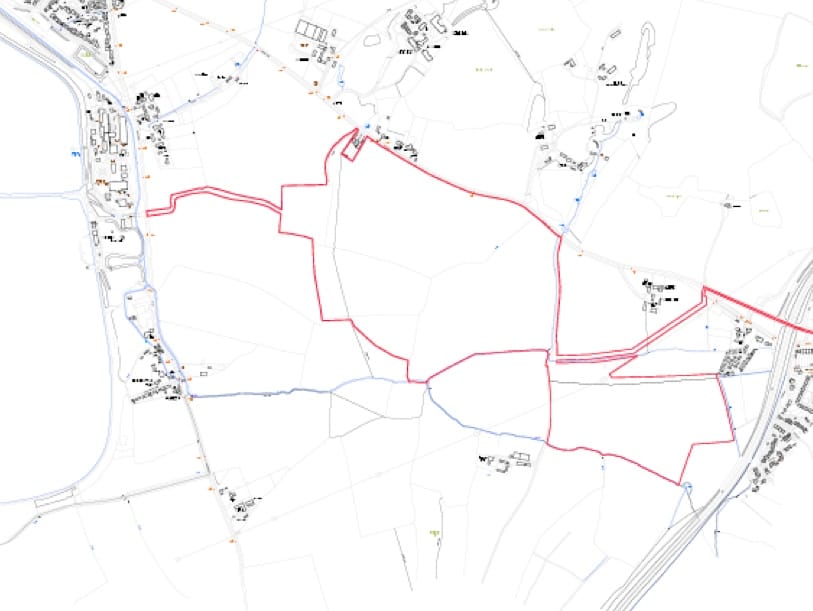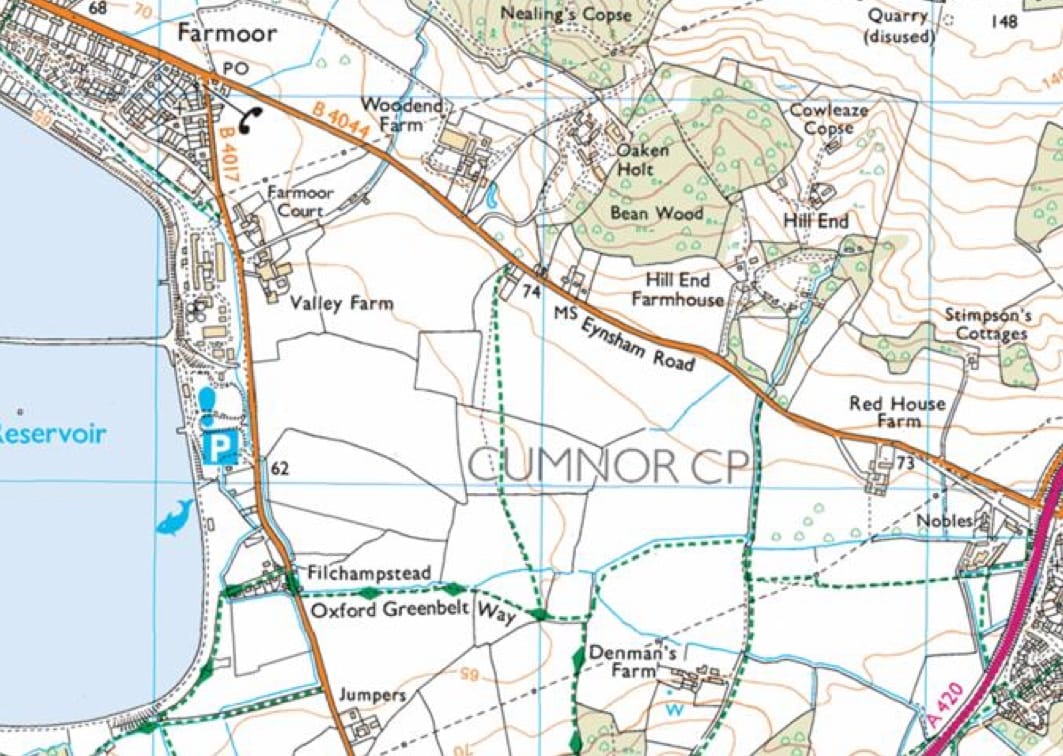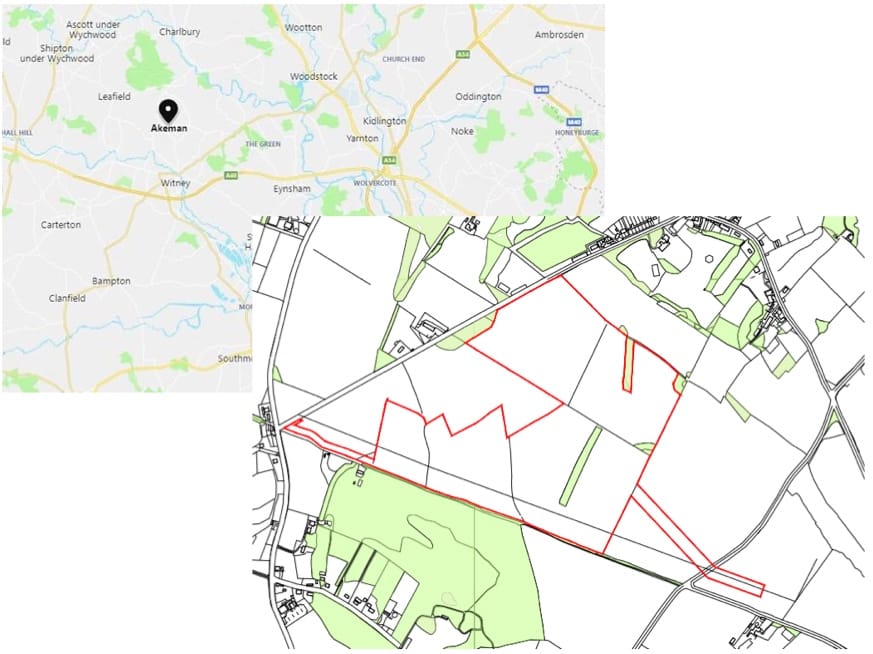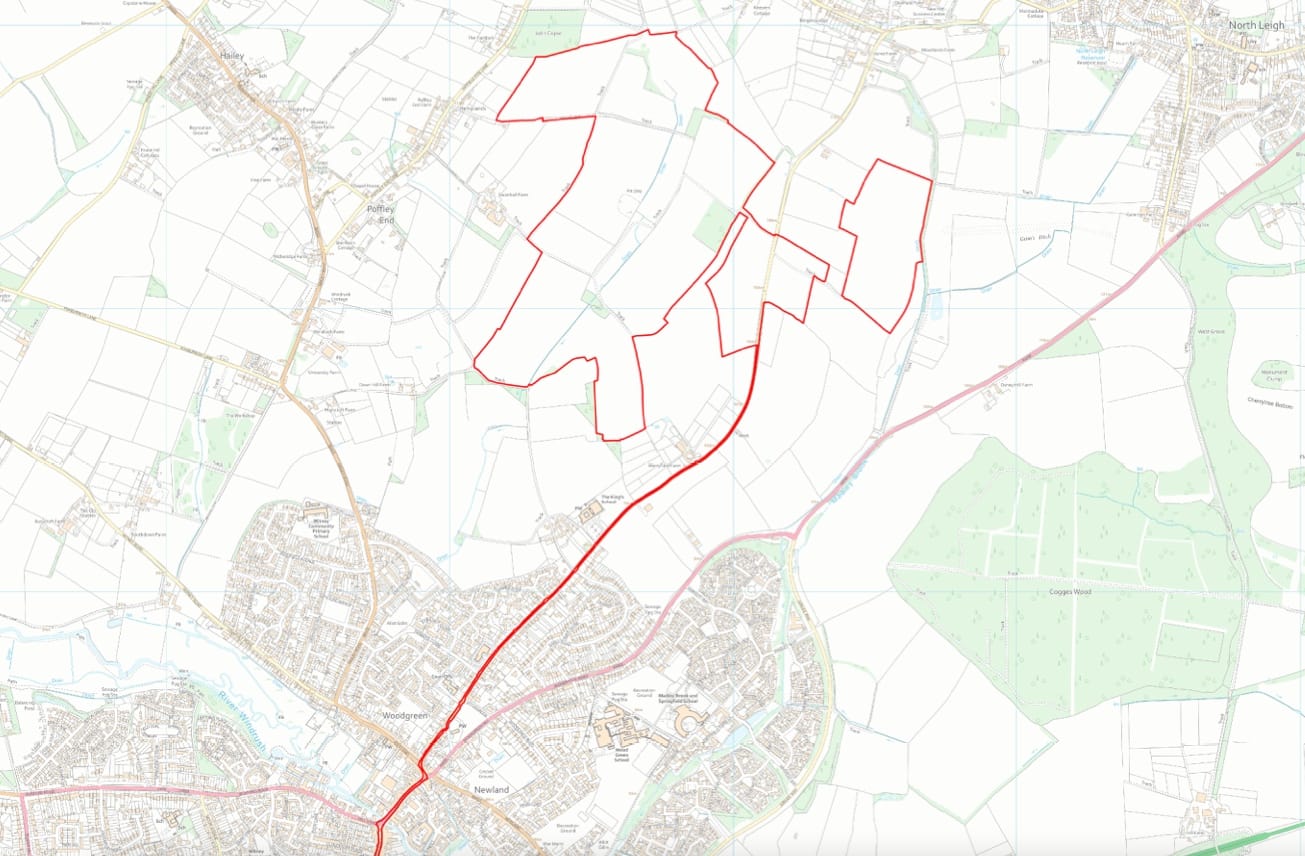Oxfordshire’s solar boom continues

It’s a mark of the investment going into solar power right now that, just a fortnight after we ran a long read on one Oxfordshire solar farm, we’re back with a round-up of the latest projects in the county.
For once, the word ‘boom’ isn’t hyperbolic. Below we highlight one village with two solar farms, and another location which could have a string of four within under ten miles.
But there is significant local opposition to the scale of these projects, on conservation, landscape and transport grounds. In this update we also include a letter from the chair of Stop Botley West, Alex Rogers – scroll down for that.
Solar update


Red House Solar Farm location: redline plan and Ordnance Survey map.
Red House Solar Farm in Cumnor would sit on a 160-acre site just to the east of Farmoor Reservoir. The site is currently agricultural, part of Oxford’s Green Belt – indeed, the Oxford Green Belt Way footpath runs past the site – and bordered by the busy B4044 and B4017 roads. It’s a revision of a 2024 proposal that was withdrawn after planning officers made several adverse comments.
The developers are keen to stress their green infrastructure credentials, with “new hedgerows to reinstate the traditional field pattern and size where it has been locally lost” and the creation of a wet woodland copse. Peak generating capacity would be 49.9MW, the ubiquitous design standard to avoid the 50MW threshold where the decision is taken nationally rather than locally.
Inevitably there is local opposition. The Oxford Preservation Trust highlights its impact on the Green Belt. Cumnor parish councillors say that the site floods frequently, that the B4044 will be disrupted for 250 days while cables are laid, and that there hasn’t been any co-ordination with the nearby Botley West project.

Hanwell, just north of Banbury, is proposed for a 40MW solar farm by Elgin Energy. The site is once again agricultural land but doesn’t have Green Belt or other conservation/biodiversity designation. Right now, the plans are at the earliest stage, where the planning consultants ask the local council whether they really want to insist on an Environmental Impact Assessment being drawn up. (They probably won’t.)

Ramsden in West Oxfordshire is just outside the Cotswolds National Landscape (aka Area of Outstanding Natural Beauty or AONB), though the village is no less attractive for that.
An ongoing proposal for a 20MW solar farm was resubmitted in January, the third time this particular scheme has been lodged. Again, alterations have been made based on feedback from district council planners and residents. The changes are principally to reduce the visual impact on the AONB and the Roman road, Akeman Street, an unmade track which runs along the site edge. The plan also includes a battery energy storage system, or BESS, which seeks to even out the energy supply from the solar farm.
Ramsden Parish Council remains unimpressed, saying “The proposals will have a harmful impact on the current landscape and represents the industrialisation of a rural environment.” Historic England says changes are needed to alleviate harm to the Ramsden Conservation Area.
The Ramsden site is just three miles from an existing solar farm at Southill near Charlbury, five miles from Aurora Solar Farm outside Eynsham, and under two miles from our next one:

Quarry Solar Farm would be between Witney and the villages of North Leigh and Hailey. Plans were submitted last June for a 35MW build with BESS by RWE Renewables, a subsidiary of the German energy giant. An earlier application for the site was refused. Once again, the changes are principally in positioning the panels (reducing visual impact from nearby footpaths and roads) and ecology (hedgerows/woodland).
North Leigh Parish Council’s objection mostly focuses on road safety and traffic issues. Witney Town Council offered no objections, while Hailey Parish Council objected but with a remarkably detailed and nuanced responses which is better than we sometimes see from principal councils, let alone volunteer-run village bodies.
Berinsfield in South Oxfordshire is another two-for-the-price-of-one solar village. South Oxfordshire District Council had refused planning permission for a 49.9W solar farm with BESS at Burcot, a hamlet just outside Berinsfield. The developers took it to appeal, and in early March, a Planning Inspector decided to overturn the refusal.
There were two reasons behind this decision. First was that the Government has now introduced the concept of the ‘Grey Belt’ – and that this site, which is in Oxford’s Green Belt, qualifies as such. The second was on the loss of agricultural land, and we’ll quote directly from the Inspector’s judgement:
Overall, the policies and guidance indicate that careful consideration needs to be given to the use of BMV [Best & Most Valuable] land but whilst the use of poorer quality land is preferred there is no prohibition on the use of BMV land.
Even at a district level the impact of the loss of this amount of BMV land for arable production would be minimal… The proposal would change the use of the land for a period of 40 years. Whilst this is a significant period of time it is not permanent. Moreover, although it would be taken out of arable production, it is proposed that the land would be used for both energy production and sheep grazing.
I am satisfied that resting the land from intensive arable farming would improve soil health through increasing soil organic matter, soil carbon and soil moisture.
Why are we highlighting some fairly arcane planning matters? Because we suspect this line of argument will play out again and again across Oxfordshire, not least at Botley West. The scenario (arable land, 40-year solar farm, sheep grazing proposed) is the standard playbook for solar developments. Council planners don’t like having to defend themselves against an appeal, and here, the Planning Inspector has set out exactly what she thinks of a typical Oxfordshire solar application.
This will be Berinsfield’s second solar farm. There’s already one at Burcot Lane on the other end of the village, confusingly not really near Burcot itself. This received permission last week to extend its permitted lifespan from 25 to 40 years.
An incoherent muddle?
Every week sees another set of calls to reform the planning system. But rounding up these projects, we have been struck by how frequently planners, local residents and activists (both for and against) reinvent the wheel with each application – laboriously researching and writing responses to plans that don’t differ that much in the round. Though the Clarion broadly starts from a position of great sympathy with renewable energy, we can’t disagree with this objection to one project by the Oxford Preservation Trust:
This application is the latest in a series of small piecemeal solar farm applications submitted across the Oxford Green Belt, lacking strategic allocation… We urge officers and policy makers to produce a strategy for the location of renewable energy schemes across Oxfordshire. Without such a strategy, applications will be determined on a piecemeal basis, with no consideration of the cumulative impacts.
Hailey Parish Council made a related point, that the level of ‘community benefit’ expected of solar developers is little more than a finger-in-the-air guess – which will trend towards the minimum the developers think they can get away with.
Unfortunately, WODC does not have a policy on the appropriate levels of Community Benefit Grants associated with the installation of Solar Panels. We recommend that they consider creating one.
The Burcot appeal could show the way that decisions will go in the future. It is, arguably, time for the planners to get on the front foot. When Oxfordshire’s councils are reorganised, perhaps the first task of the new council(s) should be to draw up a coherent solar planning policy?
Botley West – the case against
Earlier this month, as part of our Infrastructure Week series, we took a look at the arguments for the proposed Botley West Solar Farm to the north-west of Oxford. Professor Alex Rogers is the chair of the Stop Botley West campaign group, and contacted us to expand on the case against.
Your recent extensive feature Will the sun shine on Botley West Solar Farm? (March 12, 2025) contained a great deal of well-researched information about the scale and potential impact of the proposed Botley West Solar Farm, including a summary of the ten key arguments put forward by the Stop Botley West community group against the planned development.
Unfortunately, instead of offering the group an extensive interview, as you provided to the proposed Botley West developer, you included several misleading and inaccurate implications about Stop Botley West’s membership and motives. These statements were cited from another media source that were challenged after initial publication.
To set the record straight:
The Duke of Marlborough is not a member of the Stop Botley West group, much as we would welcome him. As a Woodstock Parish councillor, his official duties include membership of several council committees, and a liaison role with two outside bodies including Stop Botley West. So far, he has had no liaison with Stop Botley West.
Stop Botley West does not have any "political backers". We are a registered company formed by a group of unaffiliated volunteers working through a small Steering Group to use our individual skills and experience to research and substantiate information and arguments to counter the proposed Botley West development.
This is our mission statement:
Stop Botley West is a community group of volunteers dedicated to protecting the heritage, environment and amenities of Oxfordshire, Cherwell, Vale of the White Horse and Oxford from significant and long-term damage caused by the proposed Botley West utility-scale solar power station.
We will achieve this by stopping or significantly reducing the scale of the Botley West proposal while promoting alternative renewable energy solutions to achieve the decarbonisation of Oxfordshire’s economy. These viable alternatives include:
- community solar farms
- solar on rooftops, brownfield and industrial sites
- energy-saving measures targeted at households, industry and transport, all of which will bring direct benefits to the residents of West Oxfordshire.
We believe that the United Kingdom’s ambitious climate targets must be sustainably achieved by:
- reducing greenhouse gas emissions through community-supported renewable energy strategies
- promoting the health and wellbeing of all of our citizens
- protecting the rich heritage of the area
- reversing the current decline in biodiversity.
We encourage Oxford Clarion readers to contact us (stopbotleywest.com) to meet and learn more about our campaign.
With best wishes.
Prof Alex Rogers
Chair, Stop Botley West
